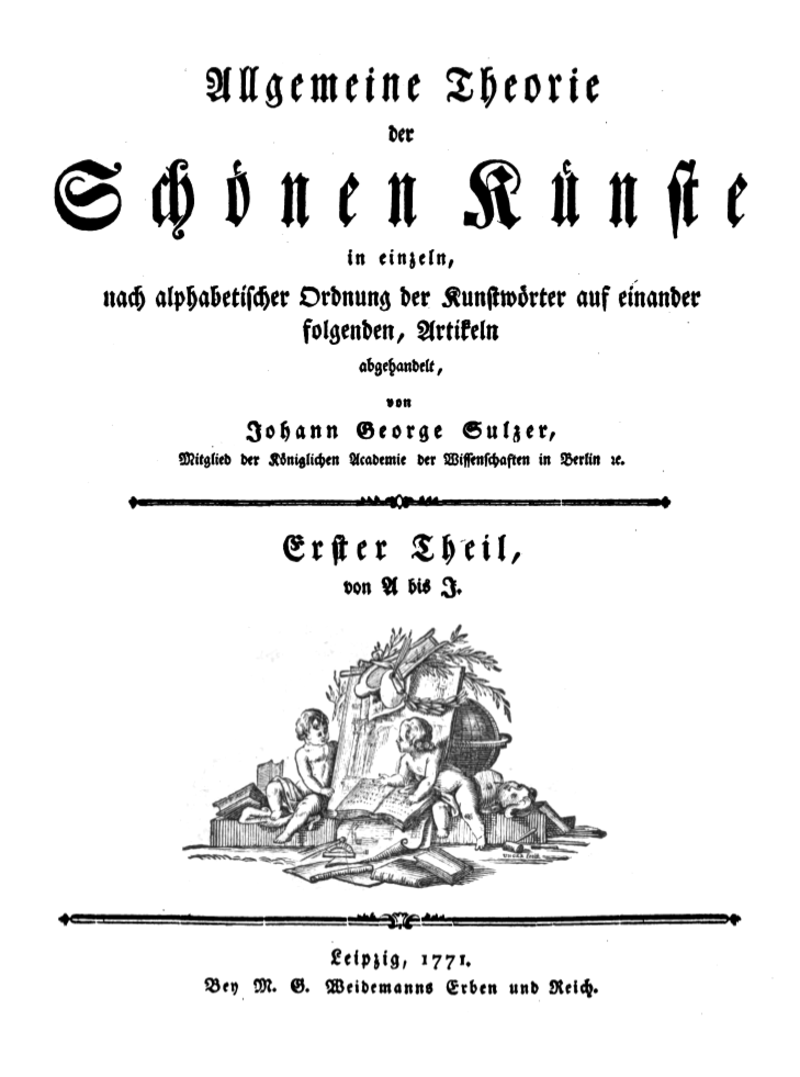Edition of the Collected Writings of Johann Georg Sulzer
Project manager: Prof. Dr. Elisabeth Décultot
Project associates: Philipp Kampa M.A., Dr. Jana Kittelmann
Duration of project: 1.4.2015 - 31.1.2020
In this ten-volume edition of his Collected Writings (Gesammelte Schriften, ed. Hans Adler and Elisabeth Décultot, Schwabe Verlag, Basel), Johann Georg Sulzer's publications as a member of the philosophical section of the Berlin Academy will be edited alongside his aesthetic, scientific, pedagogic and literary-historical writings, as well as unpublished correspondences that demonstrate the variety of the fields of knowledge with which Sulzer engaged.
Project Description
Johann Georg Sulzer: Ein Knotenpunkt der intellektuellen Geschichte des 18. Jahrhunderts
Both scientifically and institutionally, Johann Georg Sulzer (1720-1779) is a nexus in the intellectual history of the C18th. As a member of the philosophical section of the Berlin Academy he is primarily known as the as the author of A General Theory of the Beautiful Arts (1771-1774; Allgemeine Theorie der Schönen Künste), a major contribution to the theory of art and aesthetics of the Enlightenment, which was read widely well into the C19th. Alongside his work on art and art anthropology, Sulzer also authored pedagogical writings, travel reports, literary criticism, literary works and scientific investigations.
Johann Georg Sulzer and the Berlin Academy
In Berlin, where Sulzer settled permanently in 1747 after intermediary periods in Zurich, Maschwanden and Magdeburg, he cultivated many contacts amongst intellectuals and scholars. He could thank their support to no small degree on his being accepted as a full member of the Academy. In a letter to Maupertuis from 1747, Friedrich II had considered accepting Sulzer to the Académie royale des Sciences et Belle-Lettres as a specialist in “algebraic equations.” Nonetheless, Sulzer was accepted to the Academy three years later not as a mathematician, but a philosopher. His membership in the section for “speculative philosophy” (philosophie spéculative) led him to focus his intellectual activities on psychology, aesthetics and ethics. First as a member, and from 1776 as the director of the philosophical section, Sulzer exercised an important influence on the Academy. His significance lay not only in his intellectual activities, which can be judged by the number of his publications in its yearbooks, but also in his active participation in the Academy's admissions procedure and its distribution of prizes.
Contact with Lessing, Nicolai and Gleim
In Berlin, Sulzer - a close confidant of Johann Jakob Bodmer and, like him, an "anti-Gottschedian" - was in contact with Gotthold Ephraim Lessing, Friedrich Nicolai und Moses Mendelssohn. He sporadically collaborated on Lessing's Letters Concerning the Latest Literature (Briefe, die neueste Literatur betreffend). In 1750-51, together with Karl Wilhelm Ramler, he edited Critical Notices from the Kingdom of Learning (Critische Nachrichten aus dem Reiche der Gelehrsamkeit). Ewald Christian von Kleist, who died in the Battle of Kunersdorf, and Johann Wilhelm Ludwig Gleim belonged to Sulzer's circle of friends since his Magdeburg days. Along with Gleim, Sulzer was one of the first supporters of Anna Louisa Karsch and composed the preface to her Exquisite Poems (Auserlesene Gedichte).
Johann Georg Sulzer’s contribution to aesthetics
Johann Georg Sulzer made a decisive contribution to the theory of art of the C18th, the importance of which is based on the number and scale of the works he dedicated to the field. From the Study of the Origin of Pleasant and Unpleasant Feelings (Recherche sur l'origine des sentimens agréables et désagréables, 1751-1752) to the The Concept of Genius (Analyse du génie, 1757), On Energy in Works of Fine Art (De l'énergie dans les ouvrages des beaux-arts, 1765) and the General Theory of the Beautiful Arts (Allgemeine Theorie der Schönen Künste, 1771-1774), Sulzer produced a corpus of writings that was viewed as an essential, if somewhat disputed, source of art-theoretical thought well into the C19th. His contemporary admirers included, amongst others, Herder, who celebrated him as a ground-breaking pioneer of aesthetics; Friedrich Schlegel mentioned him respectfully many times, his brother August Wilhelm Schlegel referred to him and Gottfried Keller's Heinrich Lee reads the General Theory of the Beautiful Arts reverently, a book that "must have enjoyed an enormous circulation in its time, since it can be found in nearly ever old bookcase." Even the highly critical review of the essay on the "Beautiful Arts" published by Goethe in 1772 in the Frankfurt Scholarly Notices (Frankfurter Gelehrte Anzeigen) can, for all its vehemence - or perhaps on account of this vehemence - be read as a testimony to the importance of the text it attacks. That Sulzer's major work, the General Theory of the Beautiful Arts, was composed in the form of an encyclopaedia made no small contribution to the endurance of its influence.
The editorial project: A desideratum in Enlightenment research
In the light of such a wide reception, access to Sulzer’s works, which have sparked a growing interest for several years, remains editorially unsatisfactory. At present, his aesthetic writings are either available in the original C18th edition or an uncommented facsimile published by the Olms Verlag (1974). That Sulzer, following Christian Wolff and Baumgarten, made a decisive, early contribution to the emergence of aesthetics as a science of sensation has since become clear. The exact extent of Sulzer’s work and its importance, in particular in the field of aesthetics, nonetheless remains to be seen. One of the major concerns of this editorial project is to provide the textual foundations for this investigation.
At the centre of the editorial project is the philologically reliable presentation of Johann Georg Sulzer’s writings. This ten-volume edition will allow readers, for the first time since the C18th, to gauge the significance of his multifaceted work in its entirety. Furthermore, with a detailed commentary, it will illuminate Sulzer’s writings within their historical and systematic context.
Collected together, the writings of Sulzer presented here should form the prerequisite for a reconstruction of the development of his thought in a field spanning intellectual history, epistemology, psychology, aesthetics, philosophy and education. Last but not least, the edition will also help revise traditional and outdated views of the period classified as the Enlightenment and will hence critically illuminate the tradition that refers to the Enlightenment. Sulzer's writings, in their dealings with contradictions and fractures, do not pass seamlessly into the knowledge system of the time, at least according to the picture of the Enlightenment as a culture dominated by "one-sided" rationalism.
Overview of the volumes of the Sulzer edition:
| 1 | Concise Notion of All Sciences (1st and 2nd ed.) |
| 2.1/2.2 | Writing on psychology an aesthetics |
| 3.1-3.4 | General Theory of Fine Arts |
| 4 | Writings on philosophy and religion |
| 5 | Writings on the doctrine, philosophy, and science of nature |
| 6 | Writings on education |
| 7 | Poetry and literary criticism |
| 8 | Travel accounts, writings on geography |
| 9 | Life testimonies |
| 10.1/10.2 | Correspondence Sulzer-Bodmer |
The order of knowledge: Johann Georg Sulzer’s Concise Notion of All Sciences (Kurzer Begriff aller Wissenschaften)
The first volume of our edition, which was published in April 2014, presents Sulzer’s first important publication: A Concise Notion of All Sciences and Other Aspects of Learning (Kurzer Begriff aller Wissenschaften und andern Theile der Gelehrsamkeit), which appeared in many editions. With it, Sulzer contributed to the genre of “Kompendien-Literatur” – that is, the “sort of books that want to create order within the highly complex terrain of knowledge." (Hans Adler in the volume's introduction, p.lxi). Since the text was completely changed between the first and second editions, the first (Leipzig 1745) and the reworked and expanded second (Leipzig 1759) are edited critically here. Across the different editions of this work we see, amongst other things, how the new science of aesthetics, which in 1745 still played a secondary role, came to take a central place within Sulzer's panorama of the sciences.
Johann Georg Sulzer in the network of Enlightenment correspondence
Johann Georg Sulzer played a central, but scarcely editorially tapped, role in the network of Enlightenment correspondence. Here, Sulzer was an active and well-connected letter writer. The collection of letters he left behind is correspondingly extensive. It includes, amongst other things, correspondences with Jakob Bodmer, Johann Wilhelm Ludwig Gleim, Christian Fürchtegott Gellert, Jean Henri Samuel Formey, Friedrich Nicolai, Hans Caspar Hirzel, Johann Georg Zimmermann, Martin Künzli, Wilhelmine Keusenhoff and Philipp Erasmus Reich.
Letters from and to Sulzer can be found in various European archives. The most important institutions with Sulzer collections are, amongst others, the Zentralbibliothek Zürich, the Freie Deutsche Hochstift Frankfurt am Main, the Biblioteka Jagiellońska Kraków, the Gottfried-Wilhelm-Leibniz-Bibliothek Hannover and the Gleimhaus Halberstadt. So far, only a small part of Sulzer's correspondence has been published. Publications have primarily appeared in collections of letters and biographical treatises from the C18th and C19th such as Hirzel's biography Hirzel to Gleim via Sulzer the Sage (1779; Hirzel an Gleim über Sulzer den Weltweisen) and Letters from the Swiss: Bodmer, Sulzer, Gessner (1804; Briefe der Schweizer Bodmer, Sulzer, Gessner), edited by Wilhelm Körte from Gleim's literary remains. Körte's editorial practice, which included numerous cuts, changes, omissions and even expansions, certainly does not hold to today's philological and editorial standards.
New insights: Sulzer and Bodmer’s correspondence
This edition will for the first time transcribe, edit and annotate the complete correspondence between Johann Georg Sulzer and Johann Jakob Bodmer. These letters, stored in the manuscript archives of the Zentralbibliothek Zürich, represent one of the most comprehensive and completely preserved correspondences of Sulzer’s.
The correspondence, which lasted more than thirty years, is not only of interest from cultural-historical and literary-historical perspectives. It touches on important stages in both Sulzer and Bodmer’s lives and work and furthermore provides new insights into the literary life of the time. Moreover, the letters provide important information concerning the genesis of numerous works by both writers – for example, of Sulzer’s General Theory of the Beautiful Arts.
In addition to the printed edition of Sulzer and Bodmer’s correspondence, an index is planned of the collected letters from and to Sulzer. This index will be made available electronically on the project’s website and will undergo further expansion.
Publications
- Annika Hildebrandt and Steffen Martus (ed.): Johann Georg Sulzer: Dichtung und Literaturkritik. Basel 2020. 244 p. (co-supervised by the edition team in Halle; J. G. Sulzer: Gesammelte Schriften. Kommentierte Ausgabe, vol. 7).
- Elisabeth Décultot and Jana Kittelmann (ed.) in collaboration with Baptiste Baumann: Johann Georg Sulzer – Johann Jakob Bodmer. Briefwechsel. Kritische Ausgabe, 2 pt. Basel 2020. 1994 p. (J. G. Sulzer: Gesammelte Schriften. Kommentierte Ausgabe, vol. 10).
- Jana Kittelmann: Zwischen geselliger Praxis und Lesbarkeit für die Nachwelt. Zur Funktion von Briefabschriften Johann Georg Sulzers. In: Duplikat, Abschrift & Kopie. Kulturtechniken der Vervielfältigung. Ed. Andrea Hübener, Jörg Paulus and Fabian Winter. Göttingen 2020, pp. 155–172.








